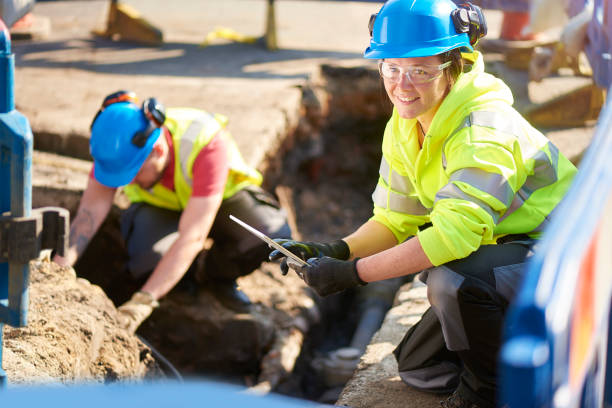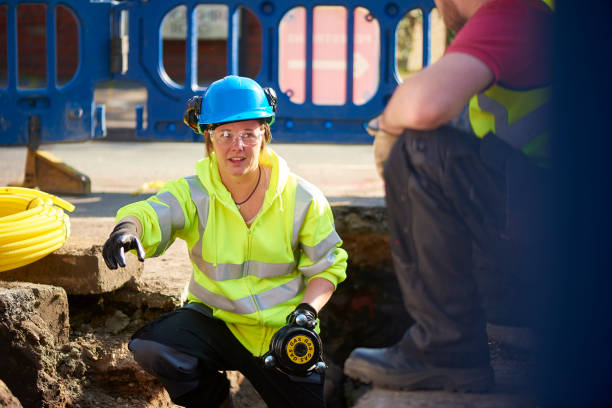Construction projects often involve a lot of vehicles, equipment, materials and workers moving around the worksite. If not managed properly, this can create safety hazards, delays, congestion, and environmental impacts. That’s why worksite traffic management is a crucial aspect of any construction project, not just on the road but also in commercial spaces where roadblocks may be necessary.
What Is Worksite Traffic Management?
Worksite traffic management is the process of planning, implementing and monitoring the movement of vehicles, equipment, materials and workers within and around the worksite. It aims to ensure the safety of all parties involved, minimise disruption to the public and the environment, and optimise the efficiency and productivity of the project.
Key Components of Effective Worksite Traffic Management
Traffic Assessment: Identify potential traffic-related risks and hazards unique to the construction site. This can be determined by creating a thorough traffic management plan.
Designated Traffic Routes: Establish clear paths for vehicles, pedestrians, and cyclists to ensure safe movement. If roadblocks are necessary, map out an alternative route to prevent traffic congestion.
Signage and Communication: Use proper signage, signals, and communication tools to guide traffic and provide important information. Make sure they are all visible and readable even at night.
Speed Control: Implement appropriate speed limits and speed-reduction measures within the construction site. This prevents major accidents caused by going over the speed limit.
Separation of Traffic: Keep vehicles, equipment, and pedestrians separate whenever possible to prevent accidents. Make sure small and large vehicles have separate lanes so they do not overlap and cause accidents.
Training and Education: Educate workers, drivers, and visitors about traffic management protocols and safety procedures. There are a lot of road safety campaigns and courses available for commercial and non-commercial use.
Regular Monitoring and Review: Continuously assess the effectiveness of traffic management measures and make adjustments as needed. Keeping up to date with traffic management measures gives you ideas on which measures work and which don’t.
Why Worksite Traffic Management Plans Are Critical for Compliance
Worksite traffic management plans ensure legal compliance, enhance safety, and improve efficiency. They help mitigate risks, prevent accidents, and keep projects on schedule by regulating vehicle and pedestrian movements. A detailed plan demonstrates adherence to safety laws, reduces liability, and builds public trust. Key elements include clear signage, designated pathways, speed limits, and emergency protocols. Prioritizing traffic management safeguards workers, maintains compliance, and supports project success.

Benefits of Worksite Traffic Management
When managing a worksite or construction site around the highway, effective worksite traffic management is important and provides the following benefits:
Safety Enhancement
Safety is the top priority on any construction site. Proper traffic management ensures workers, drivers, and pedestrians can navigate the site without unnecessary risks. Clear signage, designated paths, and controlled speed limits help reduce the potential for accidents and injuries.
Risk Reduction
Construction sites are inherently filled with hazards, and traffic-related incidents can lead to serious injuries or fatalities. Effective traffic management reduces the likelihood of collisions, slips, and falls by establishing guidelines that everyone on the site must follow.
Efficiency Improvement
A well-managed traffic system optimises the movement of vehicles and equipment, minimising congestion and delays. This improves efficiency in material deliveries, waste removal, and overall project progress.
Regulatory Compliance
Many jurisdictions have regulations and guidelines in place for worksite traffic management. Adhering to these regulations not only ensures legal compliance but also demonstrates a commitment to worker safety and community well-being.
Stakeholder Satisfaction
Construction sites often operate in close proximity to residential and commercial areas. Effective traffic management minimises disruptions to local traffic and reduces noise, dust, and pollution, enhancing relationships with nearby residents and businesses.
Cost Savings
Accidents and delays can result in costly consequences, including medical expenses, legal fees, project timeline extensions, and increased insurance premiums. By investing in thorough traffic management, construction companies can avoid these expenses and maintain a favourable bottom line.
Project Reputation
A construction project’s success is not only measured by its physical outcomes but also by the reputation it earns. Implementing proper traffic management showcases a commitment to professionalism and safety, bolstering the project’s image and the company’s brand.
Environmental Considerations
Worksite traffic management can include provisions to minimise the project’s environmental impact. By optimising traffic flow, reducing idling times, and managing emissions, construction sites can contribute to sustainability goals.
Worksite traffic management requires careful planning, coordination and communication among all stakeholders, including the project owner, contractor, subcontractor, supplier, regulator, utility provider and the public, to achieve these benefits.
To make your worksite traffic management efficient, consider the following steps:
-
- Conducting site assessment to identify the existing conditions, potential hazards and traffic flows
- Developing a traffic management plan that outlines the objectives, roles and responsibilities, procedures, equipment and signage, contingency measures and evaluation methods
- Obtaining the necessary approvals and permits from the relevant authorities
- Implementing the traffic management plan by installing the appropriate signage, barriers, cones, lights and other devices
- Training and educating the workers, drivers and visitors on the traffic rules and regulations
- Monitoring and reviewing the traffic situation regularly and making adjustments as needed
- Documenting and reporting any incidents, issues or feedback
Worksite traffic management is not a one-time activity but an ongoing process that requires constant attention and improvement. By following the best practices and standards in worksite traffic management, construction projects can achieve their goals safely, efficiently and sustainably.
It is a vital aspect of construction project planning and execution. It goes beyond merely ensuring smooth traffic flow; it prioritises safety, efficiency, regulatory compliance, and stakeholder satisfaction. By investing in well-designed traffic management strategies, construction companies can create a secure and organised environment that fosters successful project outcomes, upholds their reputation, and contributes positively to the surrounding community.

Worksite Traffic Management: Good Practice Guidelines
Safetrak Northland is committed to ensuring safety and efficiency at worksites with effective traffic management solutions. Our practices align with Good Practice Guidelines, focusing on clear signage, traffic flow control, and minimizing risks to workers and the public. By adhering to these standards, we help create safer worksites that comply with New Zealand’s health and safety regulations. Partner with Safetrak Northland for expert traffic management tailored to your project needs
Safetrak Northland Is Your Trusted Partner for Worksite Traffic Management
-
- Conducting site assessment to identify the existing conditions, potential hazards and traffic flows
- Developing a traffic management plan that outlines the objectives, roles and responsibilities, procedures, equipment and signage, contingency measures and evaluation methods
- Obtaining the necessary approvals and permits from the relevant authorities
- Implementing the traffic management plan by installing the appropriate signage, barriers, cones, lights and other devices
- Training and educating the workers, drivers and visitors on the traffic rules and regulations
- Monitoring and reviewing the traffic situation regularly and making adjustments as needed
Safetrak Northland is the leading traffic management services provider in New Zealand. Over the years we’ve operated, we’ve served a wide range of areas and helped both commercial and non-commercial customers. The company has worked on a variety of projects throughout the Northland region, from Cape Reinga to Whangarei, since its inception in 2019.
Safetrak Northland employs a team of qualified and experienced employees committed to providing excellent service and satisfying customers. Safetrak Northland takes pride in being a reliable partner in road and infrastructure solutions. We put safety, dependability, and customer satisfaction first.
Contact us today for assistance with any of your traffic needs, +64 080072338725 or admin@safetraknorthland.co.nz!

